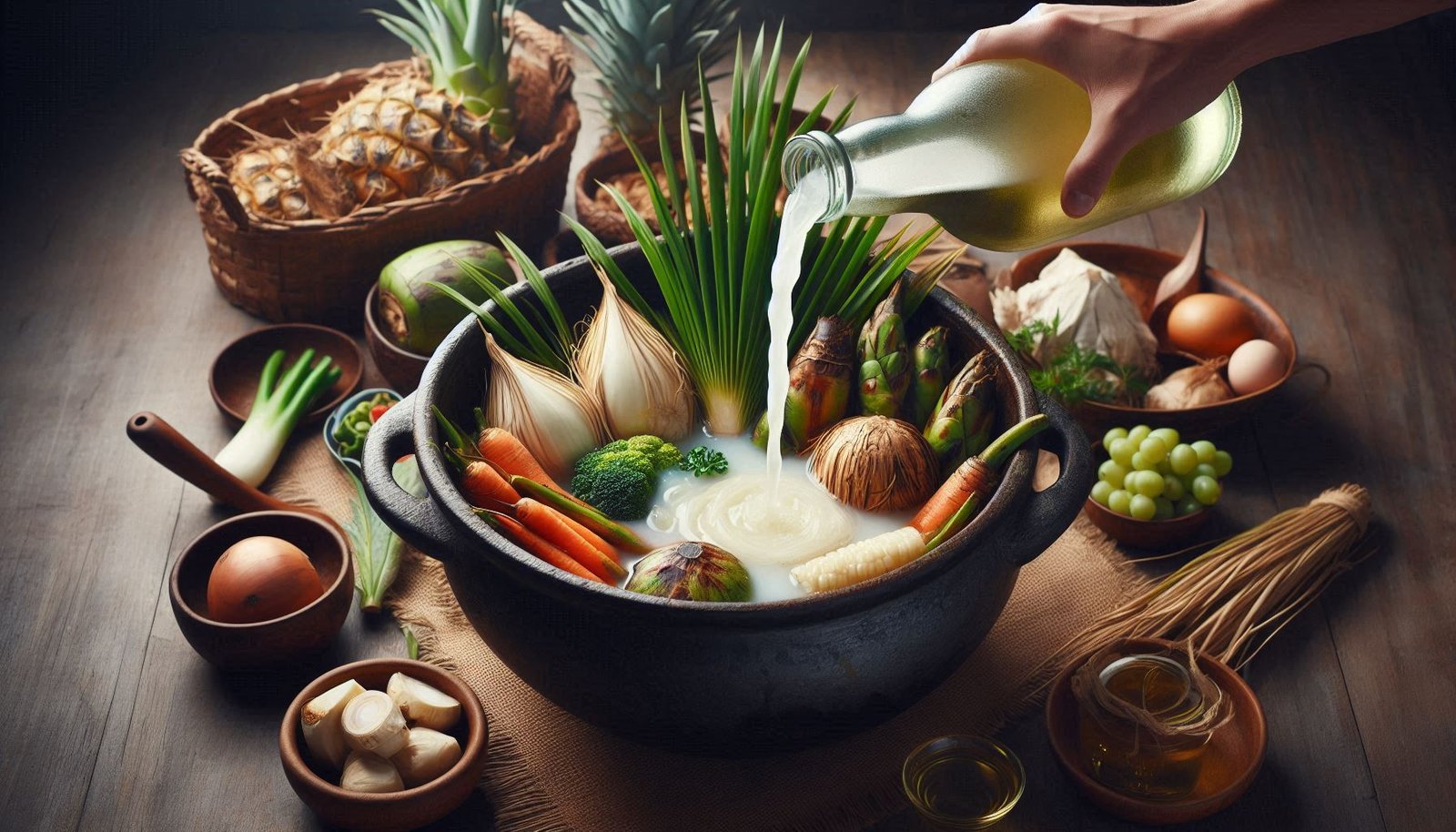Introduction to Palm Wine in Culinary Arts
Palm wine is a traditional beverage that has been an integral part of the culinary traditions in various regions, particularly in Africa and Asia. Derived from the sap of palm trees, it is a naturally fermented drink with a rich cultural heritage. The process of harvesting palm wine is both an art and a science, involving the tapping of the palm tree’s sap, which is then collected in containers. This practice has been passed down through generations, and the methods employed can vary significantly from one region to another, reflecting the diverse cultural practices surrounding this unique beverage.
The flavor profile of palm wine is one of its most intriguing aspects. Freshly tapped palm wine is sweet and effervescent, somewhat akin to a natural soda. As it ferments, the flavor evolves, becoming more complex with a slightly sour and tangy taste. This dynamic range of flavors makes palm wine a versatile ingredient in culinary arts, lending itself to various dishes and culinary innovations. Chefs and home cooks alike are drawn to palm wine for its ability to enhance both sweet and savory dishes with its distinctive taste.
The fermentation process of palm wine is a natural one, driven by the wild yeasts and bacteria present in the environment. This spontaneous fermentation not only contributes to the unique flavor but also offers potential health benefits. Fermented foods and beverages are known for their probiotic properties, which can aid in digestion and promote gut health. Palm wine, with its natural fermentation, is no exception and is often celebrated for its potential health advantages.
In conclusion, palm wine’s cultural significance, unique flavor profile, and natural fermentation process make it an intriguing ingredient in the culinary world. Whether used in traditional recipes or modern culinary experiments, palm wine continues to captivate the palates of those who explore its rich heritage and dynamic taste.
Traditional Dishes Featuring Palm Wine
Palm wine, a fermented beverage derived from the sap of palm trees, has been an integral part of culinary traditions across various cultures. Its unique flavor profile, characterized by a slight sweetness and tang, enhances a variety of traditional dishes. In Nigeria, for instance, ‘Palm Wine Chicken’ and ‘Ofe Akwu’ (Palm Wine Soup) are notable examples where this ingredient is central to the recipes.
‘Palm Wine Chicken’ is a delightful Nigerian dish where chicken is marinated in a mix of palm wine and spices. The fermentation qualities of palm wine tenderize the meat, imparting a distinctive flavor that is both rich and complex. This dish is typically prepared for special occasions and community gatherings, underscoring its cultural significance.
‘Ofe Akwu,’ on the other hand, is a traditional soup made from palm fruit extract, often enhanced with palm wine. This dish is a staple among the Igbo people and is typically served with rice or yam. The addition of palm wine to the soup not only enriches the taste but also complements the nutty undertones of the palm fruit, resulting in a hearty and flavorful meal. Such dishes are commonly prepared during cultural festivities, reflecting their importance in communal and familial bonds.
In the Philippines, ‘Kilawin’ is a traditional dish akin to ceviche, where raw fish is marinated in a mixture that includes palm wine. The acidic nature of the palm wine aids in cooking the fish, while infusing it with its characteristic tang. This dish is a popular choice for social gatherings and is often enjoyed as an appetizer or a main course.
Other regional specialties that incorporate palm wine include various stews, marinades, and sauces, each reflecting the culinary heritage of their respective cultures. The use of palm wine in these recipes not only enhances the flavors but also symbolizes the deep-rooted traditions and communal ties associated with these dishes. Through its multifaceted usage, palm wine remains a cherished ingredient that bridges culinary practices with cultural heritage.
Modern Culinary Innovations with Palm Wine
In recent years, palm wine has transcended its traditional boundaries, finding a place in modern gastronomy. Chefs around the globe are embracing this ancient beverage to craft innovative dishes that marry the rich, earthy flavors of palm wine with contemporary culinary techniques. As a versatile ingredient, palm wine offers a unique profile that enhances a variety of gourmet creations, from savory dishes to sweet indulgences and refreshing cocktails.
One of the most popular modern uses of palm wine in the kitchen is in marinades. By infusing meat, poultry, or seafood with palm wine, chefs are able to tenderize proteins while imparting a nuanced depth of flavor. The natural sugars in palm wine caramelize during cooking, creating a delectable crust and adding layers of complexity to the dish. A palm wine-infused marinade might include additional ingredients such as garlic, ginger, lemongrass, and chili, tailoring the infusion to the desired taste profile.
Reduction sauces are another area where palm wine shines. After being simmered and reduced, palm wine transforms into a concentrated liquid that can be used to enhance the taste of sauces served over meats, vegetables, or pasta. This reduction process intensifies the natural sweetness and acidity of the wine, allowing it to meld seamlessly with other ingredients like shallots, herbs, and spices. The result is a rich, velvety sauce that elevates the entire dish.
Desserts have also been revolutionized by the inclusion of palm wine. Palm wine sorbet, for instance, is a refreshing treat that highlights the drink’s delicate flavor. By combining palm wine with fresh fruits, sugar, and a bit of lemon juice, chefs create a light, icy dessert that serves as a perfect palate cleanser. The effervescent quality of palm wine adds a subtle sparkle to the sorbet, making it an intriguing alternative to traditional fruit sorbets.
The cocktail scene has equally embraced palm wine, with mixologists devising creative concoctions that showcase its unique properties. Whether mixed with tropical fruits, herbs, or even spirits like rum and gin, palm wine cocktails offer a refreshing twist on classic drinks. The natural effervescence and mild sweetness of palm wine make it an ideal base for a variety of mixed beverages, adding a touch of exotic flair to any drink menu.
Through these innovative uses, chefs and mixologists are not only preserving the cultural heritage of palm wine but also pushing its culinary boundaries. The fusion of traditional and modern techniques allows for endless creativity, ensuring that palm wine continues to be a celebrated ingredient in the culinary world.
Tips for Cooking with Palm Wine at Home
Cooking with palm wine can transform your culinary creations, infusing them with unique flavors that are both exotic and familiar. For home cooks eager to experiment, sourcing quality palm wine is the first step. Look for reputable vendors who offer fresh, unadulterated palm wine, ensuring its natural sweetness and slight sourness are preserved. Once sourced, proper storage is crucial; keep palm wine refrigerated to slow down its fermentation process, which helps maintain its delicate flavor profile.
When incorporating palm wine into everyday cooking, its versatility shines. In stews, palm wine acts as a tenderizing agent, enhancing the overall richness of the dish. A simple palm wine stew can be made by sautéing onions, garlic, and tomatoes before adding your choice of protein and a generous splash of palm wine. Simmer until the flavors meld together, creating a robust, hearty meal.
For marinades, palm wine’s slightly acidic nature makes it perfect for tenderizing meats. Combine it with herbs, spices, and a touch of oil to create a marinade that infuses your proteins with depth and complexity. Allow the meat to soak for several hours or overnight for optimal results.
Surprisingly, palm wine can also be a secret ingredient in baking. Its natural sweetness and fermented character can enhance the flavors of cakes and bread. Try substituting a portion of your usual liquid ingredients with palm wine in banana bread or pound cake recipes. The subtle, unique taste will undoubtedly impress your palate.
However, cooking with palm wine comes with its challenges. Managing the fermentation process is essential; using palm wine that has over-fermented can result in an overly sour taste. Pairing palm wine with other flavors also requires a delicate balance. Its distinct profile pairs well with robust, earthy flavors, such as ginger, garlic, and chili, while complementing the sweetness of ingredients like coconut milk.
By following these tips, home cooks can explore the culinary potential of palm wine, creating dishes that are both innovative and delicious. The journey of culinary adventure with palm wine is as rewarding as it is flavorful.












